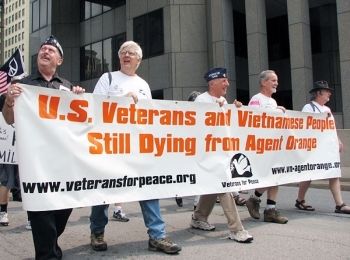
Publisher:
Bonnie King
CONTACT:
Newsroom@Salem-news.com
Advertising:
Adsales@Salem-news.com

~Truth~
~Justice~
~Peace~
TJP
Apr-04-2014 19:49

 TweetFollow @OregonNews
TweetFollow @OregonNews
Agent Orange Exposure Appears to Double Risk of Invasive Skin Cancer
Article by Annette M. BoyleIssue needs to be studied on a larger scale.
 Mark Clemens, MD |
(HOUSTON) - (note: last year, Portland VAMC cancer researcher Dr. Mark Garzotto published in Cancer his dramatic findings which also used the word, "double." In that case, published in the journal Cancer, Agent Orange exposure doubled risks for highly aggressive prostate cancer. This is a remarkable piece of research.)
Even four decades later, veterans exposed to Agent Orange during the Vietnam War have twice the risk of developing unusually invasive nonmelanotic skin cancers compared with the general population, according to a recent study.
“We noticed a lot of veterans coming into our clinic had very aggressive squamous and basal cell carcinomas, and it seemed like there was a connection to Agent Orange exposure, but a literature search failed to find any studies that showed an association in humans,” said Mark Clemens, MD, assistant professor of plastic surgery, University of Texas M.D. Anderson Cancer Center. Previous studies have demonstrated a positive correlation between 2-, 3-, 7-, 8-tetrachlorodibenzodioxin (TCDD), the highly toxic contaminant in Agent Orange and nonmelanotic invasive skin in animals.
As of 2009, more than 485,000 veterans with Agent Orange exposure had registered with the VA. DoD and the VA recognize and provide benefits for many TCDD exposure-associated diseases, including peripheral neuropathy, amyloidosis, B-cell leukemia, birth defects, chronic lymphocytic leukemia, type 2 diabetes mellitus, Hodgkin and non-Hodgkin lymphoma, ischemic heart disease, multiple myeloma, Parkinson’s disease, porphyria cutanea tarda, prostate cancer, respiratory cancers, soft-tissue sarcomas and chloracne.
Currently, however, skin cancer is not presumptively associated with Agent Orange exposure. The latest Institute of Medicine update to the Veterans and Agent Orange report concluded that there is “inadequate and insufficient information to determine whether there is an association between exposure to Agent Orange and basal cell or squamous cell cancer.”1
That didn’t dissuade the M.D. Anderson researchers from further investigation. “In our clinic, we talked about an association on a daily basis. We wanted to systematically take the first step toward conclusively making that case,” Clemens said. “We did a pilot study with 100 consecutive patients and found a surprisingly high rate of 51% of veterans had nonmelanotic skin cancer, which is about twice what you would see in an age-matched cohort in the general population,” Clemens told U.S. Medicine. The researchers evaluated the medical records of patients who enrolled in the Agent Orange registry at the Washington, DC, VAMC from August 2009 to January 2010. The patients ranged in age from 56 to 80 years old, with a mean age of 65.7 years. Only patients with Fitzpatrick skin types I-IV (fair to medium complexions) were included in the study. The results of the study appeared in the February issue of Plastic and Reconstructive Surgery.
 |
“We compared whether they sprayed fields every day, lived and worked in the area or traversed a field once as part of work and then looked at the incidence by group,” Clemens said. Among the 30% of patients who actively sprayed Agent Orange, the risk of skin cancer was even higher — 73%. Of those who lived or worked in areas sprayed with the chemical, 46% had nonmelanotic invasive skin cancer (NMISC). For veterans who reported only traveling through areas exposed to Agent Orange, the rate dropped to 21%.
About 43% of patients had chloracne, known to be caused by dioxin exposure. The presence of chloracne increased the rate of NMISC substantially, to 80%. Cutaneous melanoma occurred in 9% of the patients, similar to the 8.8% rate seen in individuals over the age of 65 in the general population. More than one-fourth of the patients (26%) had other malignancies.
Men with lighter skin and light eye color also had increased risk. Of the 14 men with Fitzpatrick skin type I, the lightest, 10 (71%) had NMISC. Just under 60% of those with Fitzpatrick skin type II and 45% of those with type III had NMISC, while none of those with skin type IV did. Of the 38 veterans with blue eyes, 66% (25) had NMISC, as did 60% (9) of those with green or hazel eyes. The incidence rate was much lower in veterans with brown eyes, at 36%.
“The takeaway from the study is that there may be an association between Agent Orange and development of nonmelanotic skin cancer, but it needs to be studied on a larger scale with thousands of patients. What we’ve observed is very, very suspicious and supports what’s been reported anecdotally,” Clemens noted. Clemens said he and his colleagues are hoping to enroll patients in a larger, prospective study. The researchers pointed out that their study had some significant limitations, such as reliance on recalled TCDD exposure and the absence of a control group of nonexposed Vietnam-era veterans. While research continues, Clemens encouraged physicians to closely monitor veterans with Agent Orange exposure for skin cancers.
“Most patients in this group don’t fall under the screening regimen. They may not have a family history of skin cancer; they’re over 65. Even if there isn’t a formal screening recommendation, veterans exposed to Agent Orange should have a physician look them over from head to toe and check any areas where they might have skin cancer,” he suggested.
“It’s difficult with just 100 patients to stratify subcohorts to determine who is most or least at risk, but the incidence was clearly higher among individuals with fair skin and light eyes,” Clemens added. “We can say that we really need additional study to determine the relative risk within this group and how we might best help these veterans.”
- 1 National Research Council. Veterans and Agent Orange: Update 2012. Washington, DC: The National Academies Press, 2014. 2 Clemens MW, Kochuba AL, Carter ME, Han K, Liu J, Evans K. Association between Agent Orange Exposure and Nonmelanotic Invasive Skin Cancer: A Pilot Study. Plast Reconstr Surg. 2014 Feb;133(2):432-7.
 |
 |
 |
Articles for April 3, 2014 | Articles for April 4, 2014 | Articles for April 5, 2014
Quick Links
DINING
Willamette UniversityGoudy Commons Cafe
Dine on the Queen
Willamette Queen Sternwheeler
MUST SEE SALEM
Oregon Capitol ToursCapitol History Gateway
Willamette River Ride
Willamette Queen Sternwheeler
Historic Home Tours:
Deepwood Museum
The Bush House
Gaiety Hollow Garden
AUCTIONS - APPRAISALS
Auction Masters & AppraisalsCONSTRUCTION SERVICES
Roofing and ContractingSheridan, Ore.
ONLINE SHOPPING
Special Occasion DressesAdvertise with Salem-News
Contact:AdSales@Salem-News.com

googlec507860f6901db00.html



Terms of Service | Privacy Policy
All comments and messages are approved by people and self promotional links or unacceptable comments are denied.
[Return to Top]
©2025 Salem-News.com. All opinions expressed in this article are those of the author and do not necessarily reflect those of Salem-News.com.